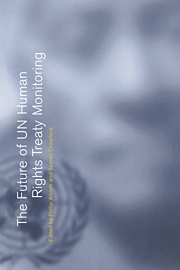Book contents
- Frontmatter
- Contents
- List of Tables, Figure, Appendices
- Notes on Contributors
- Editors' Preface
- Table of Treaties
- Table of Cases
- List of Abbreviations
- 1 The UN human rights treaty system: A system in crisis?
- A The UN human rights monitoring system in action
- B National influences and responses
- C Regional and sectoral comparisons
- D Common challenges for the treaty bodies
- 18 The problem of overlapping among different treaty bodies
- 19 Bodies of knowledge: A diversity promotion role for the UN High Commissioner for Human Rights
- 20 Treaty bodies responding to states of emergency: The case of Bosnia and Herzegovina
- 21 Ensuring effective supervisory procedures: The need for resources
- 22 Servicing and financing human rights supervision
- E Looking to the future
- Index
22 - Servicing and financing human rights supervision
Published online by Cambridge University Press: 23 December 2009
- Frontmatter
- Contents
- List of Tables, Figure, Appendices
- Notes on Contributors
- Editors' Preface
- Table of Treaties
- Table of Cases
- List of Abbreviations
- 1 The UN human rights treaty system: A system in crisis?
- A The UN human rights monitoring system in action
- B National influences and responses
- C Regional and sectoral comparisons
- D Common challenges for the treaty bodies
- 18 The problem of overlapping among different treaty bodies
- 19 Bodies of knowledge: A diversity promotion role for the UN High Commissioner for Human Rights
- 20 Treaty bodies responding to states of emergency: The case of Bosnia and Herzegovina
- 21 Ensuring effective supervisory procedures: The need for resources
- 22 Servicing and financing human rights supervision
- E Looking to the future
- Index
Summary
The background
Since their inception in the 1970s, UN treaty-based procedures in the field of human rights have become gradually better known. The number of states parties to the major UN human rights instruments has risen dramatically since 1989: with 191 ratifications the Convention on the Rights of the Child (CRC) has become the most widely ratified of any UN convention. Human rights education campaigns and programmes in many countries provide information about the various procedures, and encourage citizens to avail themselves of these mechanisms. But as always, exposure and success have their price: as more and more states ratify the various UN human rights instruments, the respective supervisory bodies have experienced increasing difficulties in coping with a growing workload under the periodic state reporting and individual complaints procedures. They must examine more periodic state reports and more complaints every year if they are to avoid an unacceptable backlog of complaints and reports, opening themselves to the charge that ‘justice delayed is justice denied’.
At the same time, the meeting time allotted to the treaty bodies in the UN conference calendar and by UN conference services has remained by and large unchanged; treaty bodies hold two to three sessions totalling six to twelve weeks of meetings each year. Requests by treaty bodies to be allotted more meeting time have met with limited success. While the workload of supervisory bodies has more than doubled over the past decade, the UN Secretariat staff resources available to service their work have, in real terms, been reduced over the same period of time.
- Type
- Chapter
- Information
- The Future of UN Human Rights Treaty Monitoring , pp. 481 - 498Publisher: Cambridge University PressPrint publication year: 2000
- 1
- Cited by

